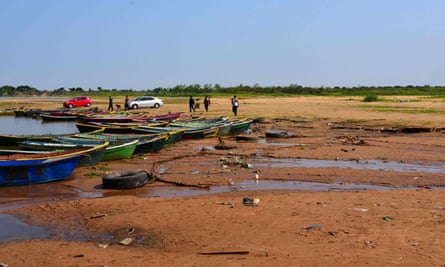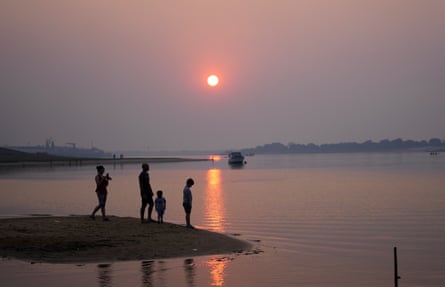In the shadow of towering grain silos that line the bank of the River Paraná, South America’s second-longest waterway, Lucas Krivenchuk stands watching workers rush to load a barge with soybeans.
“Twelve barges had to leave today, but only six will make it out: there’s no time, the water’s dropping too fast,” said Krivenchuk, general manager of the Trociuk private port in southern Paraguay. “It’s the first time that any have left in two months.”
The Paraná River, which winds through Brazil, Paraguay and Argentina, has dropped to its lowest levels in 77 years as a severe drought that began in late 2019 continues to punish the region. Experts say the climate crisis and deforestation may be intensifying the phenomenon.
The river experienced a temporary rise as Brazil released water from hydroelectric reservoirs for urgent electricity production but levels are rapidly falling.
The drought has threatened water supplies in Argentina, driven up energy prices in Brazil, and helped drive rampant wildfires across the region. Paraguay, which has no coast and relies on its rivers for countless social, environmental, and commercial services, faces dire strain.
“Paraguay is a landlocked country, and the river is an artery in its body that it depends on to live,” said Krivenchuk.

Juan Carlos Muñoz, director of Paraguay’s National Shipping and Ports Administration Body (ANNP) said river transport is central to an economy primarily based on genetically modified soy exports.
“We export commodities with zero added value: totally raw materials. River transport is by far the cheapest way of reaching international markets,” he said.
The world’s third-largest river fleet moves 96% of Paraguay’s international imports and exports along two great waterways, the Paraná and the Paraguay, to and from ports in Argentina and Uruguay.
The Paraguay River, which flows past Muñoz’s office in the capital Asunción, has dropped to its lowest ever level, further than the previous all-time low reached in 2020. With costs escalating, Muñoz said the shipping sector faces a loss of 20% of revenue – $100 million – for the second year running despite dredging initiatives.
The government – which declared a state of emergency on the Paraná in July – has already raised the alarm over rising prices of imported products.
Roger Monte Domecq, hydrology professor at the National University of Asunción, said that while cyclical droughts are normal in the Paraná Basin, there is increasing evidence that human-driven factors intensify the crisis.
“I don’t think there’s any doubt that there’s an impact on the climate, which affects conditions all across the region,” he said.
Monte Domecq said more studies were required to ascertain the exact impacts of global heating and extremely high levels of deforestation and land-use change seen across the region, especially in the Amazon where the water cycle which feeds precipitation in the Paraná Basin is being disrupted.
The CAF–Development Bank of Latin America lists Paraguay as the country most vulnerable to the climate emergency in South America.
It has also seen enormous deforestation. Only 7% of the Atlantic forest that until recent decades covered the country’s east remains, and the western Chaco forest faces some of the world’s highest deforestation rates.
Deforestation has principally been caused by state-propelled soybean and cattle ranching booms; both sectors that are now struggling to export their products downriver.

And there is no end to the drought in sight, said Monte Domecq: no significant rains are forecast for coming months and the weather phenomenon known as La Niña – which brings dry weather to the Paraná Basin – is looming.
Downriver from Port Trociuk in the fishing town of Ayolas, fisherman Claudio Domínguez described excruciating economic difficulties for ordinary families as he gathered bait in the shallows.
“There are barely any fish … really nothing. It’s been like this for four months,” he said.
Fishers are making ever-longer journeys – involving escalating fuel costs – in the hope of a catch.
Just upriver from Ayolas, production of electricity at the mighty Yacyretá dam, which Paraguay shares with Argentina, is also affected. Yacyretá and Itaipú – an even larger dam on the Paraná shared with Brazil – produce almost all Paraguayan electricity and according to the government, Itaipú has come close to shutting down due to the low waters.
Mercedes Canese, energy consultant and former deputy energy minister, said that, while Paraguay is not suffering energy shortages – it uses only a small portion of its energy from the two giant dams – it is losing an important part of $1.57bn in yearly exports of excess energy to its giant neighbours.

And as the water shortages cause Brazilian energy prices to soar, many Paraguayans say that a historical injustice is being deepened. Paraguay is obliged by treaty to sell excess energy from the Itaipú dam to Brazil at cost price, a condition that economist Miguel Carter calculates cost Paraguay $75.4bn from 1985 to 2018.
“Prices in Brazil are sky-high, but Paraguay can’t sell its energy at market prices,” Canese said. “We’re talking about a loss of hundreds of millions of dollars.”
On Ayolas’s beach, Claudio Domínguez points to a wet line in the sand indicating the Paraná’s level just hours before. He cleans his bait and hurriedly prepares for an all-night fishing trip that he hopes will not be unrewarded – as so many others have been.
In the town square, a singer serenades the crowd with Oración del Remanso, a folk song about Paraná fishers, during a festival that evening: “Christ of the fishing nets, don’t abandon us.”
“Everything depends on the river. We all depend on it,” Domínguez said.
